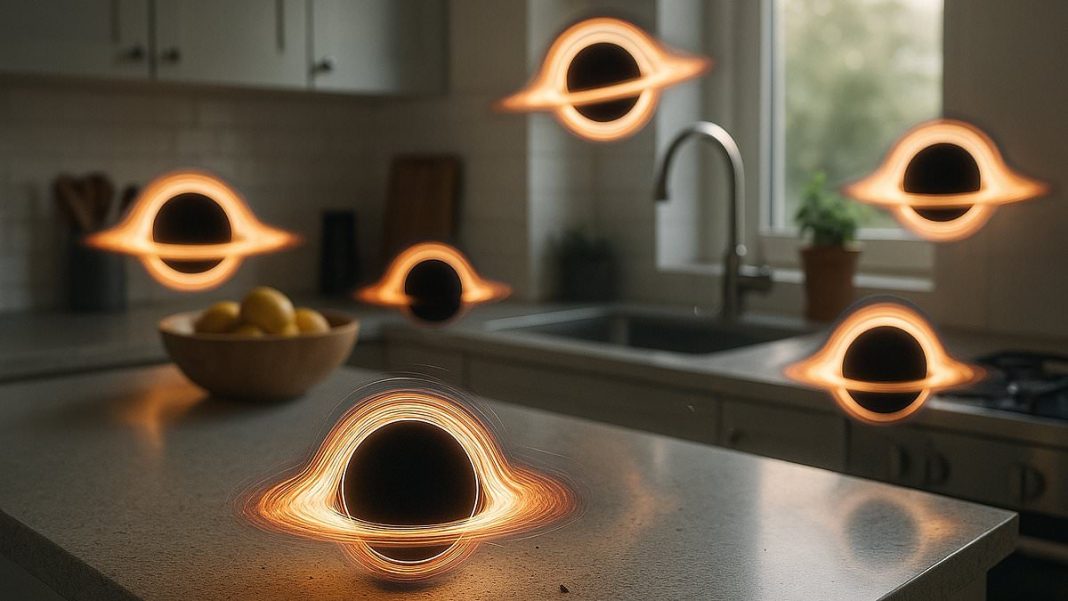Black holes are some of the most violent and destructive objects in the universe.
And as terrifying as it sounds, thousands of these mysterious voids could be whizzing through your home at this very moment.
Scientists believe the universe may be littered with objects called primordial black holes.
According to some calculations, as many as 1,000 could be passing through every square metre of the planet each year.
One of these black holes might even blast straight through your head, without you ever knowing it was there.
Primordial black holes are ancient entities formed in the very first moments of the Big Bang, which have been drifting through the universe ever since.
However, these are not the star-swallowing, galaxy-churning supermassive black holes that appear in science-fiction blockbusters like Interstellar.
Instead, they are microscopic singularities no larger than a hydrogen atom, ranging from the mass of a single bacterium to that of a medium-sized asteroid.
The black holes in your home
Typically, black holes form when a star with a lot of mass collapses in on itself until it forms an ultra-dense point known as a singularity.
These points of matter have such a strong gravitational pull that even light is pulled in – hence why they appear ‘black’.
However, primordial black holes might form in a slightly different way.
In fact, these would have formed so early on in the universe that stars wouldn’t have even had time to form.
Dr De-Chang Dai, a black hole researcher from Yangzhou University, China, told MailOnline: ‘Primordial black holes are black holes created soon after the Big Bang.
‘At this period, the temperature and energy density of the universe were very high.’
So, when small pockets of ‘overdense’ matter formed, this high energy squished them into very small black holes.
Over the 13.8 billion years that followed, some of these black holes would have slowly evaporated away through a process called Hawking Radiation, leaving behind only tiny remnants.
The main reason scientists are so interested in these currently theoretical objects is that they are one of the best candidates for dark matter.
Dark matter is a hypothetical substance which scientists have proposed to make up the mass which seems to be missing from galaxies.
Although we can’t see it or interact with it, scientists estimate that dark matter might make up around 27 per cent of the universe.
Since primordial black holes don’t radiate much energy and are almost impossible to detect, while also holding a lot of mass, they are a good fit for this role.
Professor Dejan Stojkovic, a black hole physicist from the University at Buffalo, told MailOnline: ‘In the light of all these null results from the direct and indirect dark matter searches, primordial black holes appear to be the least exotic possibility.’
If these tiny black holes really are what scientists have been calling ‘dark matter’ then they should be found almost everywhere in the universe, including in our solar system.
How many primordial black holes are there?
Since we know how much dark matter there is supposed to be, scientists can actually work out how many primordial black holes we should expect to encounter.
However, this will depend on how much mass scientists think a primordial black hole contains.
Dr Sarah Geller, a theoretical physicist from UC Santa Cruz, says that if primordial black holes exist then they probably have a mass of ‘a billion billion grams each’ – around the size of an asteroid.
Dr Geller says: ‘Supposing that they make up all of the dark matter then we can expect there to be at least one within a distance of 5 Astronomical Units from the Sun – a distance of about Jupiter’s orbit.’
Likewise, Valentin Thoss, a black hole researcher and PhD candidate at the University of Munich told MailOnline: ‘If their mass is ten trillion tonnes, which is comparable to a very heavy asteroid, there would be on average a few dozen within the planetary zone of the solar system.
‘Within 20 years we can expect one to fly past Earth at a distance of around 200 million kilometres, which is roughly the distance between the sun and Earth.’
However, the lighter each individual black hole is the more will be needed to make up the mass of dark matter in the universe, and some researchers think they could be much lighter.
Scientists used to think that black holes would eventually evaporate over time to the point that they just vanished.
But new research suggests that there might be a limit which slows down this evaporation over time until they reach a stable mass.
This could allow black holes to be much smaller than researchers had previously thought possible.
Professor Stojkovic suggests that all the primordial black holes might have shrunk to become ‘Planck mass remnants’, weighing just 10 micrograms.
At this mass, the universe would be so full of primordial black holes that 1,000 per year would pass through every square metre of Earth.
What happens if a black hole hits me?
The fact that there are black holes hanging around the solar system might sound alarming, but just how worrying that is depends on the black holes’ mass.
If the black holes are as small as Professor Stojkovic suggests they could be, then there is nothing to worry about at all.
‘1000 crossings per year per square metre is not drastic at all since 10 micrograms is about the mass of a bacteria.
‘We have trillions of bacteria around us at any moment, though they are not moving very fast.’
These tiny black holes would pass through your body without even disturbing your cells, let alone causing any noticeable damage.
As the predicted mass of the black holes gets larger the chances of one hitting Earth becomes rarer, but they also have the possibility of creating more damage.
Travelling at around 180 miles per second (300 kilometres per second) a black hole with a mass between that of an asteroid and a small planet would pass through Earth in seconds.
However, this wouldn’t be like an asteroid of normal density hitting Earth.
Because primordial black holes are so small, about the size of an atom, scientists say their passage through solid matter would be like a bullet going through a cloud.
If one were to hit Earth it might leave a very small tunnel straight through the planet and create some unusual seismic signals but otherwise wouldn’t be detectable.
But if one of these larger primordial black holes hit you, then you definitely would feel it.
Dr Geller says: ‘Most likely this wouldn’t be great for that person’s health.
‘The primordial black hole would go right through a person, and though it leaves only a very tiny hole, it might impart some velocity and give the person a real kick!’
Previous calculations suggest that a black hole with a mass of seven trillion tonnes would hit with as much force as a .22-calibre rifle bullet.
Just like a gunshot, that would be enough power to rupture organs, tear flesh, and destroy your brain.
Fortunately, this is right up at the higher end of primordial black holes possible masses and you would need to be extremely unlucky to encounter one of these.
Dr Geller says:’ In practice, the chances of such a collision are vanishingly tiny: it’s much more likely you could succeed in dropping a peanut from an aeroplane at random into a field the size of a million football fields and hit a single specific blade of grass.’






